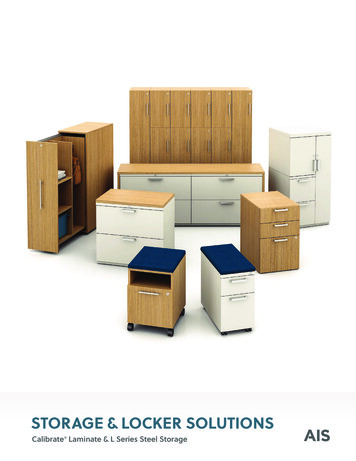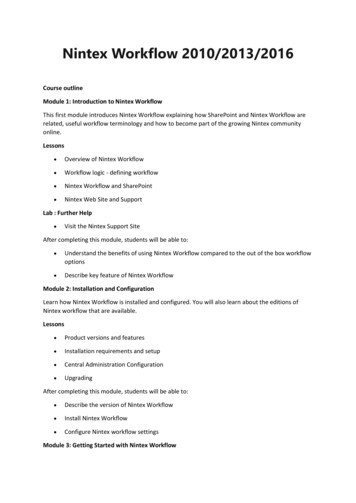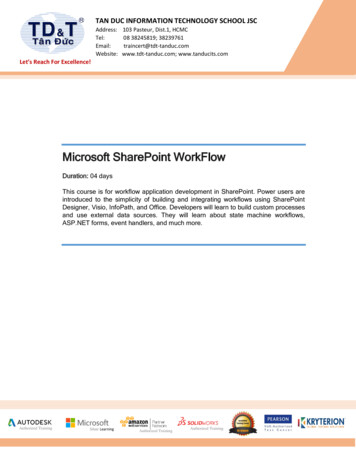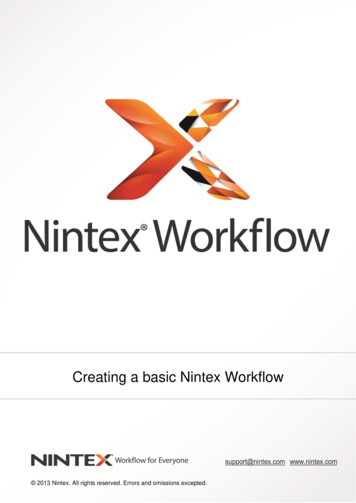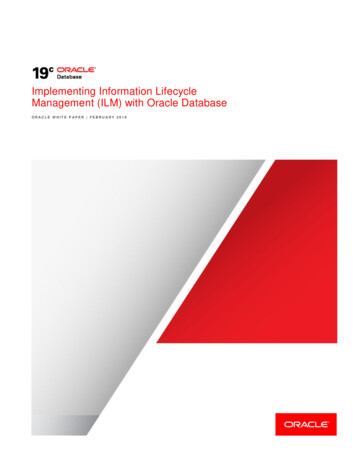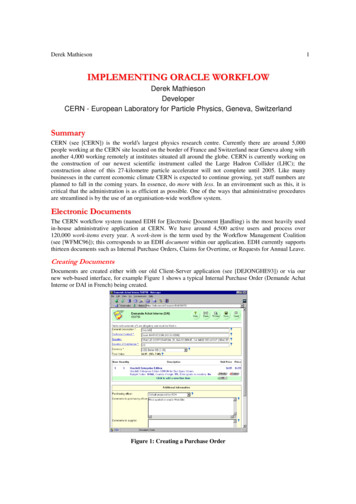
Transcription
Derek Mathieson1,03/(0(17,1* 25 &/( :25.)/2:Derek MathiesonDeveloperCERN - European Laboratory for Particle Physics, Geneva, Switzerland6XPPDU \CERN (see [CERN]) is the world’s largest physics research centre. Currently there are around 5,000people working at the CERN site located on the border of France and Switzerland near Geneva along withanother 4,000 working remotely at institutes situated all around the globe. CERN is currently working onthe construction of our newest scientific instrument called the Large Hadron Collider (LHC); theconstruction alone of this 27-kilometre particle accelerator will not complete until 2005. Like manybusinesses in the current economic climate CERN is expected to continue growing, yet staff numbers areplanned to fall in the coming years. In essence, do more with less. In an environment such as this, it iscritical that the administration is as efficient as possible. One of the ways that administrative proceduresare streamlined is by the use of an organisation-wide workflow system.(OHFWURQLF 'RFXPHQWVThe CERN workflow system (named EDH for Electronic Document Handling) is the most heavily usedin-house administrative application at CERN. We have around 4,500 active users and process over120,000 work-items every year. A work-item is the term used by the Workflow Management Coalition(see [WFMC96]); this corresponds to an EDH document within our application. EDH currently supportsthirteen documents such as Internal Purchase Orders, Claims for Overtime, or Requests for Annual Leave.&UHDWLQJ 'RFXPHQWVDocuments are created either with our old Client-Server application (see [DEJONGHE93]) or via ournew web-based interface, for example Figure 1 shows a typical Internal Purchase Order (Demande AchatInterne or DAI in French) being created.Figure 1: Creating a Purchase Order
Derek Mathieson2Once a document has been created, clicking the Send button initiates the Workflow Process.:RUNI ORZ DW &(51Workflow at CERN involves the forwarding of an electronic document to the people that are required toapprove it. Approval of a document involves the user entering their authorisation password in a speciallyencrypted field in the document. Our own auditors and all of the external institutes that wish to use EDHhave accepted this authorisation password as equivalent to a paper signature.One of the complexities of the situation at CERN is the enormous number of special workflows that werequire. The routing of financial documents has to take into consideration not only CERN’s own financialrules, but also the requirements of other institutes for whom CERN spends money. Additionally differentworking practices within the organisation are also supported which means that currently there are around270 different paths that can be chosen depending on the type of document, who created it, and whosemoney is being spent.Within Oracle Workflow Builder we have defined how each document should be routed. For example fora DAI the workflow process is defined as shown in Figure 2.Figure 2: Purchase Order RoutingThis may look simple, but each of the steps in the diagram above itself expands to another sub-processsuch as that shown in Figure 3 where the CERN Standard Financial Routing is defined.Figure 3: Standard Financial Routing6LJQDWXUH 5LJKWV 'DWDEDVHIn order that the workflow system is able to decide who has the right to sign for a particular step in theworkflow process we have a special database of signature rights for every workflow action. Most of the
Derek Mathieson3data in this signature rights database is derived automatically from our corporate databases. Theorganisation structure from our human resources database is merged with data from our financial systemto obtain a database of what accounts someone can spend from and to what limit.Figure 4 shows the basic arrangement of the organisation. CERN is divided into four Sectors, each ofwhich is split into three or four Divisions, which are in turn split into Groups, which are further split .DatabaseGroupEDHSectionFigure 4: Simplified Structure of CERNIn the Administration Division we define that a Group Leader can spend up to 10,000 Francs on anyaccount in their group, and that a section leader can spend up to 2,000 Francs on any account in theirsection. This means that either the Group Leader or the Section Leader can sign a document for 500Francs, however the signature rights are automatically prioritised, such that the section leader will beselected first. The Group Leader would be asked to sign only if the Section Leader was unavailable (forexample, on absent due to training, vacation, etc.).In a typical routing definition there are many signature actions, for example most financial documentsrequire at least one signature to authorise payment. These actions appear on the diagram like the examplein Figure 5. When the workflow reaches this step in the routing a special stored procedure is called whichdetermines who has the right to sign for the expenditure according to our signature right database. Theprocedure then uses the human resources database to select the first person that has the right to sign and isnot absent.7LPHRXW! SSURYHG . & ) 6LJQDWXUH5HMHFWHGFigure 5: A typical Signature Action:RUNI ORZ 5H (QJLQHHULQJWorkflow is not new to CERN; in fact since 1992 we have been using a workflow system that wasdeveloped completely by our own engineers. The core system was implemented in C with the processdefinitions stored in an Oracle Database. During its lifetime the system has gradually grown, new specialcases have been added, additions to the process definitions were made directly to the database using SQL.Finally the size and complexity of the system caused it to become virtually impossible to maintain.†Some Sub-Sections also exist at CERN.
Derek MathiesonWe investigated many commercial packages and commissioned an external consultancy firm to reviewthe market to try to find a replacement for our existing system. Unfortunately we could find no productthat could meet our particular requirements, and finally decided to start work on a new in-housedevelopment of a new workflow system.At that time there was a general move towards the use of Java in the development of EDH software, sowe decided to implement our new workflow engine in Java.2UDFOH :RUNI ORZAbout three months into the development of our new workflow engine Oracle Workflow was released.When we looked at the product we were very interested in its open architecture. Most of the work that wehad done until then was writing Java versions of our Common Business Objects (see [CBO99]),something that would still be useful if we adopted Oracle Workflow.*UDSKLFDO 'HVLJQOne feature of Oracle Workflow that really convinced us to use the product was the graphical processdesign tool - Oracle Builder. Graphical visualisation was one aspect that was not addressed in our originalsystem. Over the years we realised that such a capability was very important to the success of a workflowsystem. Many calls to our help desk were simply asking for explanations of the routing decisions made bythe workflow engine and without any visualisation tools it would frequently involve an engineer withSQL*Plus in order to find the answer.Oracle Builder is a Microsoft Windows Application that provides a drag-and-drop environment fordesigning workflow processes. In Oracle Workflow terminology a workflow process is called a processactivity. A process activity consists of a single start point, a series of interconnected function or processactivities and one or more end points. A function activity is a step where Oracle Workflow calls aPL/SQL stored procedure and its returned value can be used to determine which branch in the workflowshould be chosen. One useful property of this arrangement is that workflow processes can include otherworkflow processes, as a sub-workflow. This allows us to define common sub-processes that can beshared by several processes. For example, we have defined a Standard Financial Routing that is commonto all documents involving a financial transaction.In our current system (which is not yet complete) we have defined around 120 function activities and 80process activities.(UURU 3URFHVVHVAnother area in which our existing system was particularly weak was in error handling. Originally thesystem was built such that if, during the execution of the routing process an error occurred, for examplethere was no one available that could be assigned the document, an electronic mail would be sent to oneof the developers and the document would get ’stuck’. Nightly batch jobs would try to re-process anystuck documents in case a person that could be assigned the document became available, but usuallymanual intervention was required to resolve the problem. In the early day of the project this wasacceptable, but latterly the amount of time being spent by maintenance engineers trying to resolve theseproblems had become unacceptable. Oracle Workflow solves this problem by introducing errorprocesses. These processes are initiated automatically when a problem occurs in a workflow process, andallow us to introduce a more distributed maintenance structure. When a problem occurs within acustomised routing, the person responsible automatically is assigned the document, it is then theirresponsibility to resolve the problem and either allow the document to proceed or reject it.7KH 0LJUDWLRQAfter selecting Oracle Workflow we now had to undergo the process of migration. By using the primitivetools that we had already developed in order to help solve routing questions, we extracted a textualdescription of all of the process definitions from our existing system. Then started the task of introducingequivalent routings into Oracle Workflow.4
Derek Mathieson Q 2SSRUWXQLW\ WR 6LPSOLI\We saw this migration as an opportunity to look at the processes that had been introduced over the years.We tried to establish if the routings were still relevant and to standardise them as much as possible,extracting common working practices and defining them as shared sub-processes. Once we had most ofthe process definitions complete we then took them back to the divisions† and asked them to verify that itwas what they wanted. We took an active role in these discussions, pointing out non-standard practicesand highlighting areas that could be simplified. This exercise was very useful; not only for our work, butalso for the divisions themselves since it gave them an opportunity to see what workflow processes weretaking place in their division. They were aware that, as developers of the system, we were ideally suitedto see the organisation-wide view of the problems and to make suggestions for simplification.&XVWRPLVDWLRQVOne of the essential benefits of Oracle Workflow is its open architecture. This enabled us to integrate theproduct with our existing Java code relatively easily.We use Java throughout the EDH application from servlets (see [JSA98]) to implement the user interface,to the underlying Common Business Objects modelled after Enterprise JavaBeans (see [EJB98]). Thiswas our first obstacle that could prevent us from using Oracle Workflow. Oracle Workflow is extendedvia a well-defined application programmer’s interface to PL/SQL stored-procedures and although Javastored-procedures will be available soon , they are not available in our existing Oracle 7.3.3 database.To solve this problem we developed the JavaBridge.-DYD%ULGJHThe JavaBridge provides the ability of a PL/SQL stored-procedure to make a call to a Java function. Thisallows Oracle Workflow to make calls to our Java code while executing a workflow process. It isimplemented in a similar way to a remote procedure call system, consisting of two parts, a small preprocessor program (written in Java) and a multithreaded Java server.7KH 6WXE *HQHUDWRUThe pre-processor program takes as input a Java class-file containing the implementation of a functionthat we wish to use in Oracle Workflow and produces a PL/SQL stub file. The PL/SQL stub file containsan implementation of each of the functions that were in the input class file. The implementation in thestub file simply passes each of its arguments through a DBMS PIPE and then returns the response thatcomes back from the DBMS PIPE.7KH -DYD %ULGJH 6HUYHUThe Java Bridge Server connects to the other end of the DBMS PIPE and waits for messages from thePL/SQL stubs. When a message arrives, the name of the function, the argument list is extracted from it,and then a call is made to the named function. Finally, the return value from the function call is repackaged and sent back through the DBMS PIPE to the waiting PL/SQL stub. Figure 6 illustrates theoperation.†This could not be done before introducing the processes in Oracle Workflow since we had no way ofvisualising the process definitions.5
Derek Mathieson6Off Lineclass Signature{.}Stub generatorInputcreate Packagebody asSignature.GeneratesJava class fileCompileOracle DatabaseOracleWorkflowCallsPackageSignature.Java ServerDBMS PIPEPL/SQL stubclassSignature {.On LineFigure 6: The Java BridgeWe see the use of the JavaBridge as a temporary solution until Java stored-procedures are available in ourdatabase.-DYD ,QWHUIDFH %XLOGHUThe Java Bridge allows calls from PL/SQL to Java, naturally therefore we needed a mechanism of callingback to PL/SQL from Java, for example using one of the Oracle Workflow APIs to query the state of arouting. Java already has this capability via JDBC (see JDBC), but in order to simplify the structure ofour Java code we wrote a small Java application that would do some of the work for us. It reads aPL/SQL specification file and generates a Java class that exposes the same API as the PL/SQL packageusing the necessary JDBC statements. Figure 7 illustrates its operation.Original PL/SQL ProcedureGenerated Java Codeprocedure CreateProcess(itemtype in varchar2,itemkey in varchar2,process in varchar2);static public voidCreateProcess (String itemtype,String itemkey,String process) {// JDBC Statements}Figure 7: Example of Java Interface Builder Output0XOWLSOH &RQFXUUHQW 3URFHVVHVOne property of CERN internal purchase orders is that the expense can be split over more that oneaccount code. In fact, it is common that for large purchases several divisions will share the expense. Incases like these the document must be routed in parallel according to the rules specified by for eachaccount code involved. There was no easy way to support this capability in the standard Oracle Workflowproduct (since the number of budget codes can vary from one to over 20 in some cases), therefore weintroduced a special function activity which dynamically creates several sub-processes, then waits forthem to complete. If all sub processes complete with a status of Approved then the function returns with astatus of Approved. If any sub-process returns with a status of Error, or Rejected, all other sub processesare terminated, and the function returns with a status of Error, or Rejected respectively.,QWHUIDFH WR &(51 'DWDEDVHVFor a workflow system to be effective it is vital that it is capable of integrating with the existingenvironment. In effect the workflow engine is the piece that links the other applications together. AtCERN we have four main types of application that interfaces with the workflow engine.
Derek ourcesWorkflowSystemsDocumentDatabaseFigure 8: Oracle Workflow Dependencies,QWHUIDFH WR )RXQGDWLRQ 'DWDEDVHThe CERN foundation database contains the description of the structure of the organisation, officelocations, supplier details, projects, account codes, and of signature rights. This database is interrogatedby the Java function activities when determining, for example, which division owns a particular accountcode, or who has the right to approve annual leave for a particular person.,QWHUIDFH WR XPDQ 5HVRXUFHVThe HR database contains assignment information as well as details of leave; it is used by the workflowsystem when determining, for example, the supervisor of an employee, or if the person is on leave at thetime.,QWHUIDFH WR 'RFXPHQW 'DWDEDVHThe interface to the Document Database operates in both directions. The workflow system needs to querythe properties of a document, such as who created it, how much is it for, etc., and the Document Databaseis updated with information about the current state of the document (approved, rejected, etc.).,QWHUIDFH WR 5HFHLYHU 6\VWHPVThe Receiver systems are the final destination of fully approved documents. This could be the purchasingsystem for an internal purchase order, or the Human Resources database for an Overtime claim. Adocument is transferred via a specially written transfer program that is activated as the last stage of aworkflow process.3UREOHPVDuring the implementation of Oracle Workflow at CERN we encountered several obstacles that weneeded to overcome7UDQVDFWLRQ LVRODWLRQOur biggest problem was caused by our choice of Java as the language in which we implemented thelogic of the function activities. During the operation of oracle workflow calls are made to the functionactivities that make use of the JavaBridge. The use of the DBMS PIPE means that the Java running at theother end is in a different transaction than that of the workflow engine. The result of this is that the Javafunctions cannot view the current state of the document, since the workflow engine has not yet committedthe transaction. Most functions do not depend on the current state of the document, and therefore this doesnot pose a problem, but some functions do. We solved this by implementing a special message that theJava can pass back down the DBMS PIPE. This message causes the workflow engine to commit itstransaction. We realise that there are some risks with this approach, since normally the workflow enginerelies on the ability to roll back to a previous state in the event of an error, in practice, however, we havenot found any serious drawbacks with this solution.
Derek Mathieson8%XJ OHWVWe also found one or two bugs where PL/SQL variables were not defined to be a sufficient size to holdvalues from certain Oracle defined columns, luckily using the supplied source code allowed us to fix theproblem ourselves (we will be sending a bug report).One serious problem was the fact that we have around 4,500 users defined in our database. The suppliedapplet tried to show a list of all users when an administrator attempted to reassign a document to anotheruser. With the list being so long the user interface became unusable. Again, Oracle provided us withenough source code to enable us to fix this problem ourselves (although we have been told that thisproblem has been fixed in the next release of Oracle Workflow).8VHUV 3HUVSHFWLYHWe tried to make the introduction of Oracle Workflow as transparent as possible, we did this to allow us aseamless transition from the old system to the new, and if there were problems we could quickly go back!We started by running the new system in parallel with the notification system disabled. This allowed us tocompare the new system with the old, verifying that the new routing decisions were comparable to theold. Once we were satisfied that the new system was operating correctly the routing could then be silentlyswitched over.This stealth production approach means that we were unable to make use of some of the functionality thatis provided by oracle workflow.7KH ,Q 7UD\ :RUN /LVWWe already had the capability of presenting a user with a list of documents to sign, etc. Therefore we didnot need the equivalent functionality built in to Oracle Workflow.Figure 9: The EDH In-Tray SSOHWOne feature that many of our users have asked for is the ability to view a diagram of the route taken by adocument. Oracle Workflow provides such a facility via a special Java Applet. The Java Applet seemedto be a useful addition to EDH but we felt that it would need some changes before we thought it could be
Derek Mathieson9used at CERN. We were fortunate that most of the source files of the applet are supplied by Oracle, whichenabled us to begin a parallel sub-project to modify the applet.Aspects of the Applet the we felt needed changing were:Problem: The size of the viewable area of the diagram was fixed. Some of our diagrams were quite largeand a small window made it difficult to understand.Solution: The applet was changed to open a new, resizable, window when the user clicked a ‘ViewDiagram’ button on documents web page.Problem: The Applet did not allow a user to Zoom In to sub-routings that were created dynamically byfunction activities.Solution: This was the biggest change to the applet. Function activities that had created sub-processeswere specially marked so that the zoom function worked. When a user attempted to zoom in toone of these activities, where there was more than one sub-process (for example, in the case ofmany accounts sharing the cost of an order) a dialogue box is presented to the user asking themto select one of the sub-processes.Problem: The Applet provided the capability to re-assign, block, skip actions, etc., yet our existingapplication already had this capability via a different interface. We felt that providing the samefunctionality via two different interfaces could be confusing.Solution: We removed these functions from the applet. This also solved the problem that the applet didnot operate well when there was a large number of users defined (we have around 4,500 users).Figure 10: Example of Modified AppletIn the current implementation we have still not included the applet in our system as we currently have apolicy of removing client-side Java from EDH due to stability problems (primarily on Macintosh). Inaddition, the use of the Applet requires us to run Oracle Web Server which, at the moment, we are notdoing. In the future we hope to provide the modified applet to our users.'RFXPHQW 5RXWLQJ ,QIRUPDWLRQWhen a document is assigned to a user, either for signature, or simply for information, the documentstatus is updated. Figure 11 shows an example of the information that is displayed on a typical personneldocument (a Leave Request).
Derek Mathieson10Figure 11: Document Status InformationAs the document moves around between the signatories this information is maintained as a permanentrecord of all of the actions that were performed on the document. This information is available to thecreator of the document so that they can follow the progress of their document. For some types ofdocument status information is added to the document even after it has completed its workflow and beentransferred to the receiver system. For example, in Figure 12 the creator of the purchase order can seeinformation regarding their request as it is ordered, received, invoiced and finally paid.Figure 12: Status Information on a Purchase Order7LPH RXWVOnce a document is assigned to a person for signature, they have a limited time (normally three workingdays) in which to act upon it. They may postpone a decision on it, which effectively extends the deadlineby 6 months, or they may approve or reject it. If the time-out expires the time-out branch is taken whichusually is a loop back to the same signature activity. The signature activity is written in such a way that itwill ask the next person that has the right to approve the action. If the signature function is unable to findanother person, the process is marked as In Error and the Error workflow is started.1R 5HVLJQ UXOHGenerally, no person is asked to sign a document more than once. When a person approves a documentall of the signature rights that they have are applied to the document. If, later in the workflow, anothersignature right is required which is possessed by one of the people that have already signed then theactivity is immediately marked as complete with a status of Approved. In some cases this is not therequired behaviour, since some documents may be modified during the workflow process. To solve thisproblem certain signature actions have a special flag that causes them to ignore previous signatures.([SHULHQFHOne surprising aspect of the introduction of Oracle Workflow is that our Admin users now feel it is easyto introduce new modifications to the standard routings. This is somewhat contrary to our efforts toreduce the complexity and proliferation of custom routings. We currently keep control of this by requiringrouting changes to be approved by a central ’Procedures Office’, this is currently required because wehave not given write access to the database to anyone outside of the EDH team. In future we hope to relaxthis restriction and allow our EDH Admin users to maintain their routing definitions themselves, althoughthere are still questions about the guarantee of minimum standards.
Derek Mathieson11One important reason for minimising the number of steps in a workflow where each step only givesapproval, without modification to the document is the atmosphere of what might be called distributedresponsibility. If an authoriser knows that there will always be someone else to sign after them, they feelthe need for checking the details of the document is less important (since the next person will check it).The problem is of course, that if a supervisor sees that three other people already approved the documentthey are less inclined to check it! By reducing the number of approval steps to the minimum, problemslike this are eliminated.7KH )XWXUHCurrently we only use a fraction of the capabilities of Oracle Workflow. In the future we plan to use moreof the product such as the ability to sign documents via e-mail by replying to the notification message.Oracle Workflow also supports notification rules, where users can define automatic actions that areperformed when a notification arrives.&RQFOXVLRQAlthough we are still in the early stages of the introduction of Oracle Workflow, results so far areencouraging. While Oracle workflow is not as complex as some other workflow products, its powercomes from the fact that it is easily extendible. It is almost impossible to find a ready-made workflowproduct that can be integrated into an existing environment without customisation; Oracle Workflow’sopen architecture makes it possible. It has many excellent features such as the graphical design andvisualisation tool and in the future, we hope that its support for Java will improve such that we will nolonger need our JavaBridge.Finally, it is important to note that with such a large number of users and a complex organisation structureaccurate financial and personnel databases are vital to the success of this project.&RQWDFW ,QIRU PDWLRQFor more information regarding our work on Oracle Workflow I can be contacted via e-mail at:Derek.Mathieson@cern.ch5HIHUHQFHV[CBO99] .Jonsson Per Gunnar – Common Business Object CERN] .CERN - European Laboratory for Particle Physics, Geneva, Switzerlandhttp://www.cern.ch[DEJONGHE93].De Jonghe, Jurgen - The Paperless Organisation? EOUG Oracle User Forum, Vienna 1993http://edh.cern.ch/doc/Vienna[EJB98].JavaSoft - Enterprise Java Beans Specification A98] .JavaSoft - Java Servlet API l[WFMC96] .Workflow Management Coalition - Terminology & Glossary df
Oracle Builder is a Microsoft Windows Application that provides a drag-and-drop environment for designing workflow processes. In Oracle Workflow terminology a workflow process is called a process activity. A process activity consists of a single start point, a series of interconnected function or process activities and one or more end points. A .
